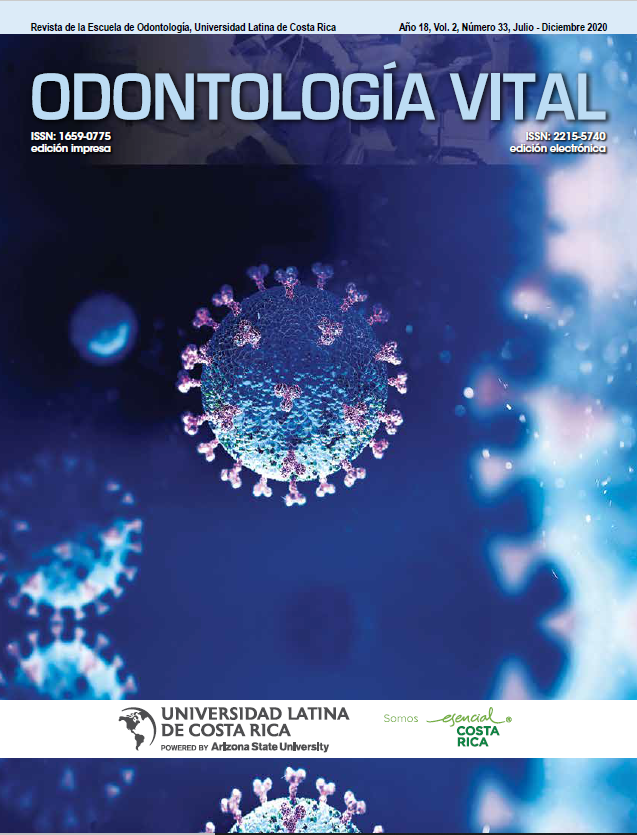Sorption of moisture and resistance to acid dissolution of two restoration glass ionomers: in vitro study
DOI:
https://doi.org/10.59334/ROV.v2i33.401Keywords:
Dental cements, glass ionomer, solubility, dental materials, acid erosion, DeSCAbstract
Introduction: Glass Ionomer has certain clinical disadvantages, such as fragility and moisture sensitivity, which might reduce the restauration´s lifespan. This effects, such as water absorption and acid solubility may damage the restauration, cause fracture and marginal filtration, this could trigger cavity relapse and the loss of the correct mechanical properties.
Objective: Compare in vitro moisture sorption and acid solution of two restoration ionomers.
Method: 20 samples of Ketac molar glass ionomer and 20 of Fuji II were made. A first weight measurement was made with precision scales, obtaining an initial weight. The specimens were submerged in distilled water for 24 hours, stored in a heater; Each sample was weighed with a precision balance, establishing the percentage of moisture absorbed from the initial weight. Subsequently, the samples were submerged in 3% citric acid solution for 24 hours, to be re-weighed, evaluating the loss of material due to erosive action of the acid in percentage of weight.
Conclusions: The moisture sorption by weight was 2.59% in the molar ketac and 1.45% in the Fuji II; When comparing the samples using the t-test, statistically significant differences were obtained. The percentage of material loss due to erosive action of the acid was 10.81% for molar Ketac and 18.62% for Fuji II; When comparing the samples using the t-test, statistically significant differences were obtained. It was concluded that the moisture sorption was higher in the molar Ketac and the greatest solubility to the action of citric acid was Fuji II.
Downloads
References
Basurto, K. E., & Barragán, N. C. (2016). Comparison of the dental leakage between Ketac™ Molar e Ionofil Molar® with centrix and ART spatula. CES Odontología, 29(2), 5-11.
Blanco, S., Frías, S., Tarón, A., Bustillo, J. M., & Díaz, A. (2017). Resistencia a la compresión del ionómero de vidrio y de la resina compuesta. Estudio in vitro. Revista odontológica mexicana, 21(2), 109-113. https://doi.org/10.1016/j.rodmex.2017.05.006
Bohner, L. O. l, & Prates, L. H. M. (2018). Compressive Strength of a Glass Ionomer Cement Under the Influence of Varnish Protection and Dietary Fluids. Odovtos International Journal of Dental Sciences, 20(3), 61-69. https://doi.org/10.15517/ijds.2018.33607
Casamayou, R., Boghosian, E. D., & Abella, R. (2016). Comportamiento de los sellantes de vidrio ionomero de alta densidad. Estudio a 6 años. Actas Odontológicas, 13(2), 33-42. https://doi.org/10.15517/ijds.2018.33607
Cosio, H., Zuñiga, G., & Zvietcovich, M. (2015). Comparación in vitro de las propiedades físico—Químicas de un ionómero de vidrio convencional, un cermet y un ionómero de vidrio modificado con aleación para amalgamp. Ciencia y Desarrollo, 18(2), 13-18. https://doi.org/10.21503/cyd.v18i2.1227
Delgado, C. R., Ramírez, J. P., & Nagano, A. Y. (2014). Liberación de fluoruro de dos cementos de ionómero de vidrio: Estudio in vitro. Revista odontológica mexicana, 18(2), 84-88. https://doi.org/10.1016/S1870-199X(14)72056-7
Hernández, R., Moraga, R., Velásquez, M., & Gutiérrez, F. (2013). Resistencia compresiva vidrio ionómero Ionofil Molar® y Vitremer® según tiempo de exposición en saliva artificial. Revista clínica de periodoncia, implantología y rehabilitación oral, 6(2), 75-77. https://doi.org/10.4067/S0719-01072013000200005
Jiménez, A., & Yamamoto, A. (2015). Valoración de la microfiltración del ionómero de vidrio mejorado (Ketac Molar Easymix ®) con o sin el uso de acondicionador. Revista odontológica mexicana, 19(3), 170-173. https://doi.org/10.1016/j.rodmex.2015.07.003
Matick, A. C. C., Navarro, C. H., Higashi, D. T., Pascotto, R. C., Fujimaki, M., & Terada, R. S. S. (2019). Avaliação da solubilidade e sorção em água de alguns materiais restauradores diretos. Revista de Odontologia da UNESP, 48, 1-9. https://doi.org/10.1590/1807-2577.12818
Piedra, L. A., Ariza, M. C., Guzmán, H. J., & Zárate, F. (2016). COMPARISON OF DEBONDING RESISTANCE AND FAILURE TYPE OF THREE ORTHODONTIC BAND CEMENTS. Revista Facultad de Odontología Universidad de Antioquia, 28(1), 95-111. https://doi.org/10.17533/udea.rfo.v28n1a5
Ríos, E., Garcilazo, A., Guerrero, J., Meade, I., & Miguelena Muro, K. (2017). Estudio comparativo de la resistencia al desplazamiento de cuatro cementos en zirconia. Revista odontológica mexicana, 21(4), 235-240. https://doi.org/10.1016/j.rodmex.2018.01.003
Rudloff, K., Haristoy, R., & Velásquez, M. (2014). Permanencia de Restauraciones Oclusales Realizadas con Técnica Restaurativa Atraumática (TRA) en Dientes Permanentes. International journal of odontostomatology, 8(1), 53-58. https://doi.org/10.4067/S0718-381X2014000100006
ŞiŞmanoŞlu, S. (2019). Fluoride Release of Giomer and Resin Based Fissure Sealants. Odovtos - International Journal of Dental Sciences, 21(2), 45-52. https://doi.org/10.15517/ijds.v21i2.36860
Taboada, M. F., Obando, P. C., Armas, A. del C., Jácome, A., & Flores, D. (2018). Grado de degradación de ionómeros de vidrio modificados con resina al contacto con diferentes enjuagues bucales: Estudio in vitro. Odontología Vital, 28, 15-24. https://doi.org/10.59334/ROV.v1i28.157
Taron, A., Frías, S., Blanco, S., Camacho, A., Bustillo, J. M., & Díaz, A. (2015). Comparación de la dureza superficial de diferentes tipos de materiales restauradores en premolares birradiculares, un estudio in vitro. Avances en Odontoestomatología, 31(6), 355-361. https://doi.org/10.4321/S0213-12852015000600003
Verón, M. G., Suárez, S. G., & Prado, M. O. (2018). Estudio de los cambios de la composición química de un ionómero vítreo mediante la técnica de PIXE. Matéria (Rio de Janeiro), 23(2). https://doi.org/10.1590/s1517-707620180002.0425
Downloads
Published
Issue
Section
License
Copyright (c) 2020 Herbert Cosio Dueñas, Gladys García Sánchez, Liceth Lazo Otazú

This work is licensed under a Creative Commons Attribution 4.0 International License.
Authors who publish with Odontología Vital agree to the following terms:
- Authors retain the copyright and grant Universidad Latina de Costa Rica the right of first publication, with the work simultaneously licensed under a Creative Commons Attribution 4.0 International license (CC BY 4.0) that allows others to share the work with an acknowledgement of the work's authorship and initial publication in this journal.
- Authors are able to enter into separate, additional contractual arrangements for the non-exclusive distribution of the Odontología Vital's published version of the work (e.g., post it to an institutional repository or publish it in a book), with an acknowledgement of its initial publication.
- Authors are permitted and encouraged to post their work online (e.g., in institutional repositories or on their website) prior to and during the submission process, as it can lead to productive exchanges, as well as earlier and greater citation of published work.







